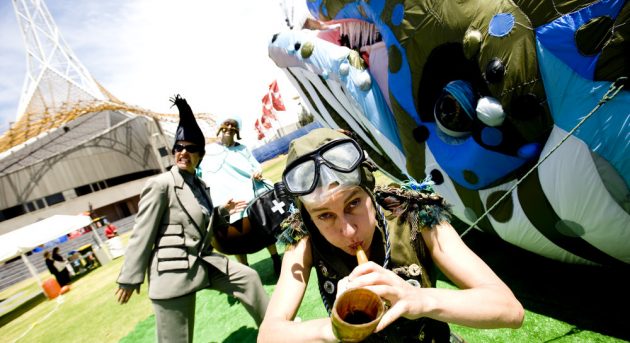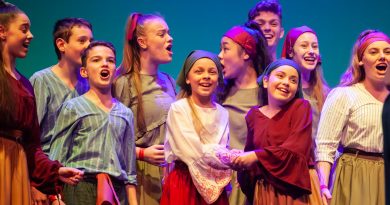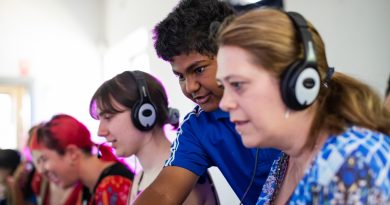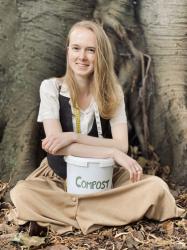The Composting Costumier talks “Art For Social Impact” with Born In A Taxi.
This interview took place between Wathaurong and Boon Wurrung Land. I acknowledge the Australian Aboriginal and Torres Strait Islander peoples as the first inhabitants and traditional custodians of the nation and pay my respects to their Elders past and present.
Recently I spoke to Carolyn Hanna from physical theatre company Born In A Taxi about their goal of “Art For Social Impact” – aiming to address big issues through deep community engagement in their works.
Born In A Taxi’s upcoming show is Take Me To Your Leader, which will be public as part of Melbourne Fringe Festival with shows on November 28 and 29 at 11am and 1pm. To view System’s People and see more of Born In A Taxi’s work head over to Borninataxi.com.au , check out their Instagram for the digital side of their most recent Covid-safe work Front Yard Frolics. Butterfly House will have its first public preview in March 2021 supported by City of Stonnington.

CC: How did you start in the world of sustainability in theatre?
CH: It’s really interesting, I got into theatre from being an activist. I studied a Bachelor of Social Sciences at RMIT majoring in Environmental Policy after high school, because I was really into [laughs] “Saving the world” and thought I was going to do it, as you do when you’re young. My undergraduate thesis was about theatre and education. I was also getting arrested doing lots of activism. I’d been really hard-line and started to realise the power of humour and theatre to change people’s hearts and minds. That took me on a whole other journey, away from environmentalism and into the world of theatre – learning skills and developing communication skills in lots of different ways and focussing on non-verbal communication through mime etc. Now I’m co-artistic director of Born I A Taxi with Penny Baron, the company’s been going for thirty years and I’ve been with them for twenty four.
I’ve always had an interest in how we as humans can do things better, but feel I also dropped the ball for many years on environmentalism (aside from the way I live my life) – schlepping costumes from one gig to another in petrol guzzling vehicles, plus, all of the realities of having children. There’s so much to learn on life’s journey and [I realised] how uncompromising I’d been as a young activist.
Independent theatre basically lives in a constant state of scarcity, which I think really helps make environmental choices.
We’re not in the same fast cycle as funded companies who spend lots of resources making a show that’s in repertoire for, if you’re lucky, one or two years and then it’s not performed again and all those sets and costumes, every bit of energy whether human or material dissipates.
We have acts we’re still doing twenty years later. Even if the materials weren’t initially recycled they’re lasting for decades – we just keep honing and making them better.
CC: It’s actually really nice to come back to shows and say “how can I make that last longer?” or “how can I build on last time and still retain the integrity of the design?”. Building on what exists rather than starting new.
CH: Exactly, we’re really into maintenance. Even with punishing international touring, when we go to a maker who makes it really well to start with it means we have the same costumes [years later], it’s amazing! It’s expensive to start with but so worth it – if you’re just in the game of what’s new and fresh, then how long does that last? The approach of “let’s not spend too much money on it now” is just part of that fast turnover and wastefulness. Laurel Frank’s costumes have always lasted the test of time. We can’t afford [to be wasteful] because we plan to be still making and performing work a long time into the future. We don’t plan on going anywhere, so everything builds upon itself.
CC: You need things that can maintain relevance when built on and not have to replace it every tour because the previous one was specifically “November 2018” fashion or the like.
CH: In fact, in one of our oldest acts called The Gold People, we wore white suits made in the 80s (very 80s – platinum blonde wigs, totally synthetic). We hit the 10 or 15 year mark and thought “we haven’t got any work with that act for several years” then Lady Gaga appears and it’s cool again, like we outlive fashion. What also comes with that is the fast paced change of gatekeepers and people who hold the purse strings. Longevity – it’s like the river that just gradually creates the smooth rock. We love that.
People who’ve really enhanced our sense of what’s possible with sustainability, especially making sets and objects, are the Bryony Andersons of this world – it’s part of her DNA. She doesn’t make things that don’t fit within a circular model where sourcing up-cycled materials offers highly innovative outcomes. She’s next level, a genius – so unassuming and smart.
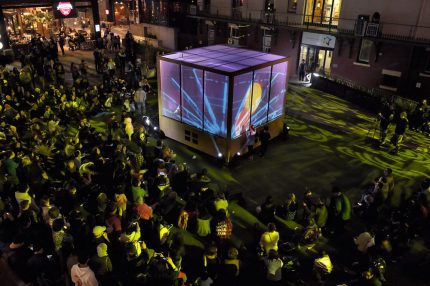
We’ve made this transparent cube from plantation wood, steel and perspex. It’s going to house our work, we imagine for the next 15 years at least. It’s not all from recyclable materials but it’s incredibly well designed and made by David Murphy to be versatile enough for a whole suite of possibilities. A concept [Bryony] created for this space was a butterfly house, where audiences make butterflies out of up-cycled chip packets that get released into this 4x4m transparent cube with an internal up-draft that keeps them flying. It’s crazy and technical, flying the butterflies, we’re still not 100% sure if it’s possible but we’re working with RMIT at the moment. Bryony can’t finish the idea because she’s now employed in Tassy, but she said, “yeah I’d love you to make [it]”.
We working with an Aeronautical Engineering professor and students and Bryony joined us for one Zoom session. The professor, based on [Bryony’s] last creative development said “I work with this wind tunnel” (a fancy, corporate thing at RMIT they’ve poured millions and millions of dollars into) “and what you’ve done, in the space of your creative development, is basically come up with the same elements of physics that we needed to create this giant wind-tunnel.”And I think “yeah, the mind of a great artist is just [like] a scientist’s.” I really appreciate [Bryony’s] curiosity about the world.
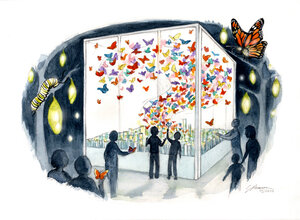
We got a partial grant from City of Melbourne to work out the technical capacity [of The Butterfly House] and experiment. We have a new lead artist, now that Bryony can’t finish the concept, who’s amazing. Her name’s Gabriel Panaanen, she’s a puppet-maker into animal flight and murmurations and has worked with museums globally. She’s quite young but extraordinary, making murmuration installations based on flock flight patterns that audiences interact with and influence.
[For the butterfly house] there’s a crafter who helps people build recycled butterflies – it’s all about circular systems, turning “rubbish” into something beautiful like nature does when things die. There’s a performer playing the butterfly catcher talking about butterflies and back gardens and handing out seedlings [to support] local indigenous butterflies and caterpillars. People engage in this creative work then go home and plant things to help real butterflies in their gardens. Increasingly, we find it more meaningful to create work that has a practical legacy as well as a magical creativity to it.
This goes to the heart of Taxi and the kind of work we’re interested in. It has high innovation and high artistic aesthetics but is also about community engagement and a practical legacy.
CC: Was Sustainability always part of Born In A Taxi and that’s why you joined? Or did you bring sustainability into the conversation more?
CH: Neither, I fell in love with the company and work by complete chance. Then we discovered we had a shared language. The engine of all Taxi’s work is ensemble improvisation. I saw “The Blue People” at Sydney festival way back in 1993 and just couldn’t work out how it was done. I was so intrigued, “How can you be so tight and loose, when you clearly don’t know what audiences are going to do, but make it look rehearsed, like the performers know what’s about to happen next? As a fan I would go and watch them everyday and went back one time to the dressing rooms and got to talk to them
The act was the brain child of Neil Thomas but three quarters of the performers were from Born in a Taxi. They said “We’re from Melbourne too”. Then, maybe three years later, after working with them on and off, myself and partner at the time became members of the company. Nothing to do with sustainability, a pure artistic intrigue about their methodology led me and then my history came in later. It wasn’t until The Whale’s Tale at Arts Centre Melbourne, that I was really first able to make my history of sustainability and love of theatre merge into one project. Those photos from the Midway Atoll in 2015, of the birds’ skeletons full of lighters and shampoo caps and all that, that was the impetus for The Whale’s Tale.
CC: I spoke to Bryony quite a bit about the Whale.
CH: It’s such a beautiful thing to see, an amazing work of art. She made the giant inflateable puppet from parachutes and 8km of cotton, off-grid in this tiny shack in the hinterlands of New South Wales. She’s got this mix of incredible engineering mind with amazing artistic aesthetic, you don’t often get those two aspects in one person.
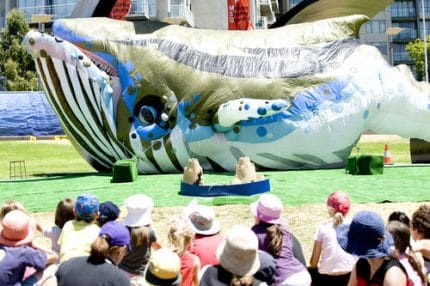
This [new project] Eco Whale uses our existing Whale’s Tale show (always building on what we’ve done). We will take it into schools in the West, which have low socio economic and high culturally and linguistically diverse students, and use it in collaboration with local businesses, local councils and recycling [programmes].
They’ve got a whole new recycling system happening in Hobson’s Bay, which is a big change that a lot of the residents are finding very difficult. We want to build on what we’ve got to empower kids to feel like they’ve got a choice – that they have agency and feel like they’re contributing. We’re still waiting on funding confirmation but are in conversation with Coles, EPA and Melbourne Water. One aspect is that the kids make their own bags and sell them to shoppers. We’re also going through local businesses, working on advocacy for children’s future, so kids can go in and ask “what are the barriers to sustainability in your business and what would help?” – creating critical thinking in primary school kids.
They start to understand the complexity – kids are getting really articulate and we have to raise our game. We take the show in and get kids on board because it’s funny and visual; and they really feel for the whale. [It’s about getting] them onside and then training around making something practical with a real world outcome. Also using their creativity and making that visible to the outside community through artwork on bins.
It’s hard with big bureaucracies, because they only change because they have to when people at the bottom of the pyramid are making them topple. Or when someone gets high up and actually says “what we’re doing is crazy, I’ve got insight and foresight and power to change things.”
Hobson’s Bay has given us an arts grant for our current idea Front Yard Frolics about taking live performance safely to residential streets and creating a Covid friendly program. People stay inside their front yards and we perform around different thematic activities each week like edible sculpture, chalk drawing, fashion in the driveway, stories from your neighbours. It’s a 4-8 week program with a coinciding social media campaign. We dress up as our Zebra characters with the aim to lessen isolation and loneliness [and address] kids feeling like the outside world is a dangerous place. It’s really about connecting safely and encouraging a sense of community.
We had a photoshoot for the local paper in this street, and just during that three houses who’d been living there for 3 years and had never met each other, came out purely because the photoshoot was something happening in their street – that was exciting! It’s working and hasn’t even started! We’ll be completing this program when restrictions lift, along with another partnering with Maidstone Community Centre in City of Maribyrnong.
Another [sustainability issue] especially for touring artists is energy and carbon footprint. We had a massive year in 2018 with the Commonwealth Games, plus going to Taiwan, America etc. That was a lot of flying and freight and feeling increasingly uneasy about it.
We’d been looking into Future Energy Artists, who started as a group of musicians who thought “We’ve got a pretty sustainable lifestyle, but what are our carbon credits during touring?” They were shocked when they worked them out. Then they got proative, and have basically started building a massive solar farm in South Australia to offset their touring.
Any artist can buy a share. The idea is that you put money into it to fund its creation, then it creates renewable energy [which goes back into the grid], so you actually receive a dividend.
CC: Would you say the biggest challenge in sustainable performance is the impact of touring?
CH: I think that’s the hardest thing to navigate. I think the current Covid-19 experience has contributed to us wanting to do more meaningful things locally.
Touring’s been part of how our company has survived over so many years. So it’s a whole new model if you take that out. I’m not saying we’re never going to tour again, but I think gone are the days when you go somewhere and do one show in one day, and you ‘ve spent 10 hours on a plane to get there.
The hardest thing even for Bryony around the Whale, was that even when she used second-hand parachutes (which I think made the whole thing) the engineer that signed-off on it said she had to have a big metal frame inside because he couldn’t guarantee the pressure of the parachutes to hold air like new material would. That’s where sustainability gets really hard, because the whale itself is completely sustainable, but to tour, it only packs down to about a 2m cube. If we transport it by truck or plane, there’s the added energy to move something that size around. It’s so complicated!
CC: It’ll be interesting to see how this broader world of digital streaming affects that. It would be a loss for people being able to experience shows live, but in terms of impact (even though the internet has an impact too) it’ll be interesting to see what comes from COVID-19 – if some companies keep digital streaming as another alternative.

CH: It opens up some really exciting avenues. We did a digital residency at Monash University with 10 students, working on a piece called Systems People, about three clowns navigating an ever increasingly systemized world that they don’t feel they’re very well suited to. It wasn’t originally meant to be digital and it was an ensemble based physical theater piece, so we were thinking “How is this going to work? It’s going to be a dog’s breakfast!” But it was actually really exciting and really worked. We created an ensemble on zoom and did a live digital showing. We had 75 people watching and 60 of them stayed for over half an hour for the Q&A afterwards.
What’s possible if you can make digital works feel or be live and responsive? With the audience able to comment in real time during the shows? It gives the audience a sense of togetherness and a pathway to influence the work, which is really interesting.
Online work developed this year is opening up so many more alternatives, though I’ll never feel the same thrill as being in a physical space with performers, sharing their heartbeat, breath and sweat.
CC: Have you reached the point as a company that you specifically look for people who work sustainably? Or does it just happen organically because of the types of artists you connect with?
CH: It’s really interesting how one’s team gets built. Over time as a company you develop a really great team, and shorthand in understanding eachother’s processes, what’s expected and how to work towards a shared goal. There’s so much that feeds into choosing somebody with both that commitment to sustainability and artistic skill level. If we had the funding, we’d ask someone like Bryony to work with us full-time. It’s a no brainer. In an ideal world, [sustainability] definitely feeds into who we work with and we’ve recently spoken to Bronwyn Pringle to help us embed ecological practises more into the fabric of the company in 2021. We have other makers whose main focus isn’t sustainability, but their artistry and quality of work is so high that in a way it also has a positive impact on sustainability.
CC: Do you have any outside of the industry sustainability tips to share? Anything exciting news about your compost?
CH: Well, our compost is currently in fallow. Both bins are full so they need a little bit more time to cook before putting on the garden. Where we live we’ve got a green bin that you can put compost in so that’s where it’s going at the moment. I hate the idea of not composting my scraps, so I’m so happy that our council has set this up, but the actual recycling situation is just shocking.
You want my bug-bear about recycling? Why are manufacturers still making packaging that is not recyclable? For example you can hardly ever recycle a cosmetics bottle, and even supermarket meat trays etc. I don’t understand why there’s no policy driving that. That would basically mean overnight we wouldn’t have that sort of landfill.
Knowing how and what to recycle is so much about education – my kids have grown up with the Whale’s Tale their whole lives and I have to say that the messaging on that show just works. Kids get it.
Through this interview Carolyn has nominated to support Rainforest Rescue.

